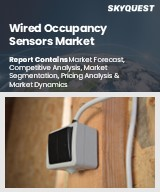
유선 재실감지 센서 세계 시장 규모는 2023년에 12억 달러로 평가되었으며, 예측 기간(2025-2032년) 동안 CAGR 8.5%로, 2024년 13억 달러에서 2032년에는 25억 달러로 성장할 전망입니다.
유선 재실감지 센서 시장은 에너지 효율적인 솔루션과 비용 절감 기술에 대한 수요 증가에 힘입어 강력한 성장세를 보이고 있습니다. 기업들은 운영 비용 절감과 에너지 규제 준수를 우선순위에 두고 있으며, 이는 센서의 채택을 촉진하고 있습니다. 스마트 빌딩과 홈 오토메이션 시스템의 등장은 이러한 추세를 더욱 가속화하여 조명, HVAC, 보안의 실시간 제어를 용이하게함으로써 지속가능성을 촉진하고 있습니다. 정확하고 안정적인 센서는 오경보를 최소화하고 에너지 사용을 최적화하는 데 필수적입니다. 그러나 대규모 배선 공사와 전문 인력으로 인한 높은 설치 비용으로 인해 특히 소규모 기업 및 일반 가정에 대한 시장 침투를 방해하고 있습니다. 또한, 무선 대체품에 비해 유연성과 확장성에 한계가 있어 전체 유선 재실감지 센서 시장의 성장을 저해하는 요인으로 작용하고 있습니다.
Global Wired Occupancy Sensors Market size was valued at USD 1.2 billion in 2023 and is poised to grow from USD 1.3 billion in 2024 to USD 2.5 billion by 2032, growing at a CAGR of 8.5% during the forecast period (2025-2032).
The wired occupancy sensors market is experiencing robust growth, fueled by increasing demand for energy-efficient solutions and cost-saving technologies. Businesses are prioritizing operational savings and compliance with energy regulations, which encourages the adoption of these sensors. The rise of smart building and home automation systems further enhances this trend, facilitating real-time control of lighting, HVAC, and security, thereby promoting sustainability. High-accuracy and stable sensors are essential for optimizing energy use by minimizing false alarms. However, high installation costs, driven by extensive wiring and professional labor, hinder market penetration, particularly among small enterprises and homeowners. Additionally, the limited flexibility and scalability compared to wireless alternatives pose challenges, slowing the overall growth of the wired occupancy sensors market.
Top-down and bottom-up approaches were used to estimate and validate the size of the Global Wired Occupancy Sensors market and to estimate the size of various other dependent submarkets. The research methodology used to estimate the market size includes the following details: The key players in the market were identified through secondary research, and their market shares in the respective regions were determined through primary and secondary research. This entire procedure includes the study of the annual and financial reports of the top market players and extensive interviews for key insights from industry leaders such as CEOs, VPs, directors, and marketing executives. All percentage shares split, and breakdowns were determined using secondary sources and verified through Primary sources. All possible parameters that affect the markets covered in this research study have been accounted for, viewed in extensive detail, verified through primary research, and analyzed to get the final quantitative and qualitative data.
Global Wired Occupancy Sensors Market Segments Analysis
Global Wired Occupancy Sensors Market is segmented by Technology Type, Application Area, Sensor Type, Functionality and region. Based on Technology Type, the market is segmented into Infrared Sensors, Ultrasonic Sensors, Hybrid Sensors, Photoelectric Sensors and Microwave Sensors. Based on Application Area, the market is segmented into Residential, Commercial, Industrial and Agricultural. Based on Sensor Type, the market is segmented into Single-Channel Sensors, Multi-Channel Sensors, Networked Sensors and Standalone Sensors. Based on Functionality, the market is segmented into Standard Occupancy Sensing, Vacancy Sensing, Daylight Harvesting Sensors and Integrated Smart Sensors. Based on region, the market is segmented into North America, Europe, Asia Pacific, Latin America and Middle East & Africa.
Driver of the Global Wired Occupancy Sensors Market
The increasing demand for cost-effective and energy-efficient sensors significantly propels the growth of the Global Wired Occupancy Sensors market. These sensors are known to reduce energy consumption by nearly 50% by intelligently managing lighting and HVAC systems based on real-time occupancy data. This not only aids building owners and operators in achieving substantial savings but also aligns with sustainability goals and ensures adherence to energy-related regulations. The efficiency of wired occupancy sensors in maximizing resource utilization and minimizing energy waste further enhances their attractiveness for both commercial and residential applications, thereby driving market expansion.
Restraints in the Global Wired Occupancy Sensors Market
The growth of the global wired occupancy sensors market faces significant constraints primarily due to high installation costs. The need for extensive wiring, specialized labor, and the potential for installation disruptions significantly inflate project expenses. These elevated initial costs especially deter small businesses and residential customers from adopting wired solutions, particularly in retrofit situations where existing setups complicate and increase the expense of rewiring. As a result, the prohibitive nature of these installation costs restricts market penetration and limits the broader adoption of wired occupancy sensors across various sectors.
Market Trends of the Global Wired Occupancy Sensors Market
The Global Wired Occupancy Sensors market is witnessing a significant trend driven by the integration of AI and IoT technologies. This synergy enables real-time data collection and advanced analytics, enhancing the capabilities of occupancy sensors to manage building systems effectively. AI algorithms analyze occupancy patterns gathered from IoT-connected devices to optimize lighting, HVAC, and security systems, resulting in improved energy efficiency, better space utilization, and heightened occupant comfort. As smart building management becomes increasingly critical, this trend is pivotal in creating intelligent environments that respond dynamically to user needs, driving growth within the wired occupancy sensors market through enhanced operational efficiency and sustainability.